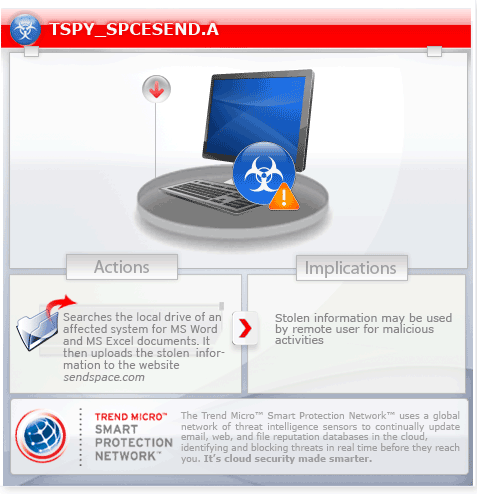TSPY_SPCESEND.A
Windows 2000, Windows XP, Windows Server 2003


Threat Type: Spyware
Destructiveness: No
Encrypted: Yes
In the wild: Yes
OVERVIEW
This spyware searches the local drive of an infected system for MS Word and MS Excel documents. The collected documents are then archived and saved. It then uploads the created archive to the website, sendspace.com.
To get a one-glance comprehensive view of the behavior of this Spyware, refer to the Threat Diagram shown below.

Upon sucessfully uploading the archive, it sends the generated download link and archive password to a C&C server. This routine exposes data, which may be used for malicious purposes to unknown users.
This spyware may be downloaded from remote sites by other malware.
TECHNICAL DETAILS
544,768 bytes
EXE
No
01 Feb 2012
Arrival Details
This spyware may be downloaded from remote site(s) by the following malware:
- TROJ_DOFOIL.GE
Installation
This spyware drops the following files:
- %User Temp%\{random}.zip
(Note: %User Temp% is the current user's Temp folder, which is usually C:\Documents and Settings\{user name}\Local Settings\Temp on Windows 2000, XP, and Server 2003, or C:\Users\{user name}\AppData\Local\Temp on Windows Vista and 7.)
NOTES:
It searches the local drive of an affected system for MS Word and MS Excel documents. The collected documents are then archived and saved using a random-generated password and archive name:
- %User Temp%\{random}.zip
It then uploads the created archive to the website sendspace.com.
Upon sucessfully uploading the archive, it then sends the generated download link and archive password to the C&C server http://www.{BLOCKED}483825.ru/send/log.php.
SOLUTION
9.200
8.753.00
04 Feb 2012
Step 1
Before doing any scans, Windows XP, Windows Vista, and Windows 7 users must disable System Restore to allow full scanning of their computers.
Step 3
Search and delete this file
- %User Temp%\{random}.zip
Step 4
Scan your computer with your Trend Micro product to delete files detected as TSPY_SPCESEND.A. If the detected files have already been cleaned, deleted, or quarantined by your Trend Micro product, no further step is required. You may opt to simply delete the quarantined files. Please check this Knowledge Base page for more information.
Did this description help? Tell us how we did.

